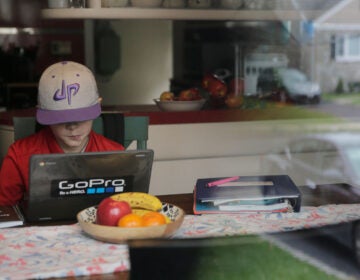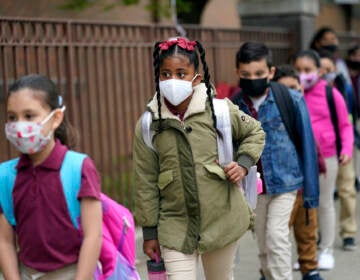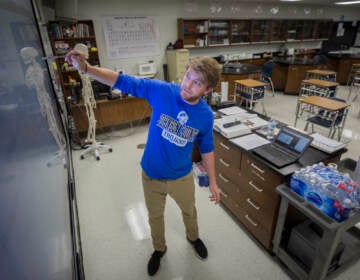Philly parents deeply divided over virtual school, data shows ahead of district decision
Families attending schools in affluent areas were about as likely to choose in-person instruction as families attending schools in low-income neighborhoods.
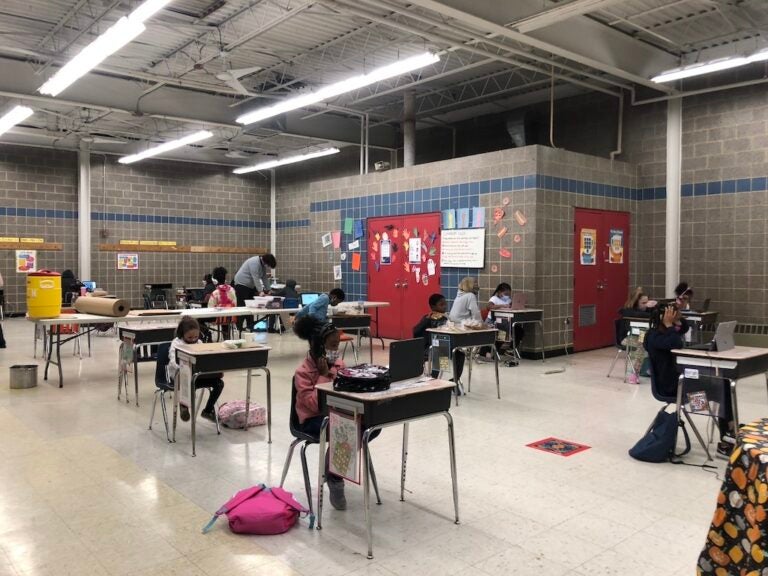
Students are socially distanced while attending class virtually at Vogt Access Center. (Emily Rizzo for WHYY)
Philadelphia’s public school system is headed toward a third attempt at offering in-person school during the pandemic. Whether it succeeds will depend partly on the cooperation of parents, who appear deeply divided on the issue.
A WHYY review of survey data from November shows that families — when given a choice between in-person learning and hybrid learning — were fairly split on the topic.
When looking at school-by-school breakdowns, few patterns emerged. Families attending schools in affluent areas were about as likely to choose in-person instruction as families attending schools in low-income neighborhoods. Similarly, survey response rates did not seem tied to school demographics.
The data has inherent limitations with the types of parents surveyed and the way the survey questions were presented to families.
That said, it’s the only time Philadelphia asked its public school families to commit to a reopening option. And it shows that the path ahead will run through a deeply divided pool of parents.
Public officials signaled in recent days that the School District of Philadelphia will attempt to reopen before the school year ends. Superintendent William Hite told Chalkbeat that he’d likely unveil a reopening plan in the next week. Mayor Jim Kenney said in a Tuesday news conference that he hopes schools will reopen in the spring after teachers are expected to be vaccinated.
This would mark the third time Philadelphia has tried to reopen schools for willing families.
The first attempt over the summer ended after loud objections from principals, teachers, and parents who testified before the school board. In November, the district tried again with a scaled-back plan to offer a “hybrid” option for students in grades Pre-K to 2nd. Under the proposal, families could choose to send their children to school a couple of days per week.
That plan disintegrated after a swift rise in cases, but it did result in a widely distributed parent survey.
Families with students in the applicable grades could choose the hybrid option or an all-virtual option. The district told families that if they chose the hybrid option they could switch, at any point, to the virtual option. But if they chose the virtual option, they’d have to stick with it until the end of the semester.
Because of that, it’s hard to know if families who choose the hybrid option truly preferred it or just wanted the flexibility to delay their decision.
The district also said that families who did not respond to the survey would be placed, by default, in all-virtual classes. Because of that, it’s hard to know if families who didn’t respond simply weren’t aware of the survey or wanted the virtual option.
Further complicating things, the district asked parents to make decisions as they were making ventilation improvements to buildings and slowly updating information about the safety of those buildings.
In the end, about a third of respondents chose the in-person option. About a quarter opted for all-virtual. And just over 40% did not respond at all.
Delving further into school-by-school breakdowns offers little clarity.
WHYY compared parent responses to the percentage of students each school classified as “economically disadvantaged.”
At schools serving fewer economically disadvantaged students, parents were more likely to choose the in-person option. But the correlation was slight.
Parents at Bache-Martin, a school located in the relatively affluent Fairmount neighborhood, were the most likely to choose hybrid learning. About 72% took the in-person option. Penn Alexander, in University City, had the second-highest proportion of parents choosing hybrid, at roughly 67%.
But the picture was far different at Andrew Jackson School, in rapidly gentrifying South Philadelphia. There, about half of parents chose all-digital — one of the highest marks in the city — and another 30% did not respond to the survey. At Albert M. Greenfield, in Center City, a similar picture emerged. About 40% of families chose digital and another 30% defaulted to that option by not responding.
Meanwhile, T.M. Peirce in North Philadelphia had the highest percentage of parents actively choosing all-virtual education — over 60%. With over 86% of students classified as “economically disadvantaged,” Peirce has among the largest percentages of low-income families in the city.
James Rhoads School in West Philadelphia has an almost identical number of economically disadvantaged students, but families there were among the most enthusiastic about in-person learning. At Rhoads, 61% of parents chose hybrid learning, the fourth-highest mark in Philadelphia.
Likewise, parents at schools across the socioeconomic spectrum were about as likely to respond to the survey. There’s little relationship between the percent of families at a school who are economically disadvantaged and the percent of families who responded to the survey.
Parents say their attitudes were largely shaped by circumstances at their individual school.
At T.M. Peirce, for instance, the school district discovered asbestos in 2019 that forced the school to close and forced families to move to an alternative building. Allegra Simms, a parent liaison at the school, believes families at her school may have been reluctant to return to in-person learning because it meant sending kids to a backup site.
“We did go through a lot with the asbestos,” Simms said. “That may have impacted parents’ decisions.”
Parents at Albert M. Greenfield told WHYY that there was widespread concern about the lack of available data on classroom ventilation, perhaps causing low interest in hybrid learning.
Sarah Singer Quast is the parent of a first grader at Bache-Martin and chose the hybrid option because she wanted her child to benefit from the socialization of in-person school, but also to give her family the flexibility to change their decision. She believes the school did a good job communicating that fact to parents, which may explain the enthusiasm for hybrid learning.
“There was really good communication from the school,” she said. “There was just real clarity.”
Next steps
Another question swirls around all of this data: Will parent opinion in November have much bearing on parent opinion when schools try to reopen in winter or early spring?
Akira Drake Rodriguez is an urban planning professor at the University of Pennsylvania. She’s been following the school reopening debate among parents and teachers and wonders about the value of old survey data in a fast-changing health crisis.
“Time really matters,” Rodriguez said.
She also wonders if parents will embrace a return to classrooms if it comes with only a few months left in the school year — long after families have established their home-learning routines.
“You’ve invested in this classroom in your home,” Rodriguez said. “Is the three months really going to make a difference?”

Get daily updates from WHYY News!
WHYY is your source for fact-based, in-depth journalism and information. As a nonprofit organization, we rely on financial support from readers like you. Please give today.



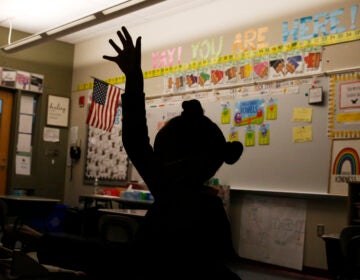
![CoronavirusPandemic_1024x512[1]](https://whyy.org/wp-content/uploads/2020/03/CoronavirusPandemic_1024x5121-300x150.jpg)
